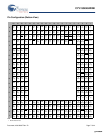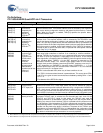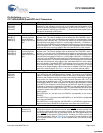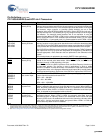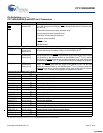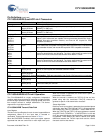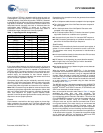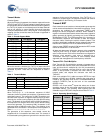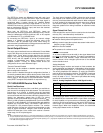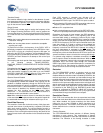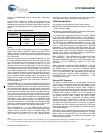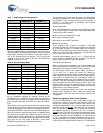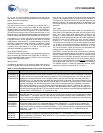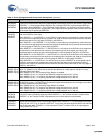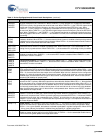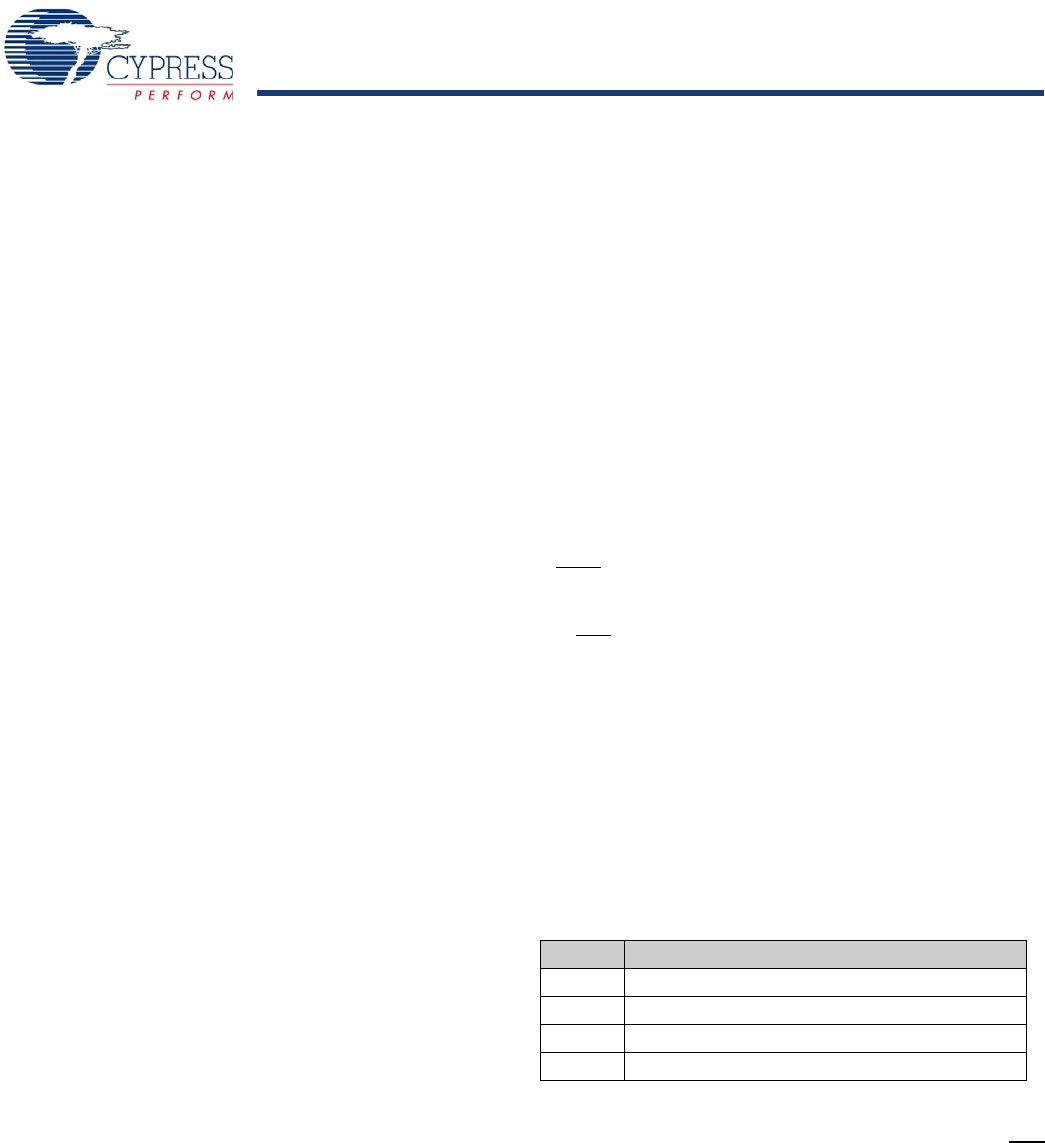
CYV15G0404DXB
Document #: 38-02097 Rev. *B Page 15 of 44
The REFCLKx± inputs are differential inputs with each input
internally biased to 1.4V. If the REFCLKx+ input is connected to
a TTL, LVTTL, or LVCMOS clock source, the input signal is
recognized when it passes through the internally biased
reference point. When driven by a single-ended TTL, LVTTL, or
LVCMOS clock source, connect the clock source to either the
true or complement REFCLKx input, and leave the alternate
REFCLKx input open (floating).
When both the REFCLKx+ and REFCLKx– inputs are
connected, the clock source must be a differential clock. This can
either be a differential LVPECL clock that is DC- or AC-coupled
or a differential LVTTL or LVCMOS clock.
By connecting the REFCLKx– input to an external voltage
source, it is possible to adjust the reference point of the
REFCLKx+ input for alternate logic levels. When doing so,
ensure that the input differential crossing point remains within the
parametric range supported by the input.
Serial Output Drivers
The serial output interface drivers use differential Current Mode
Logic (CML) drivers to provide source matched drivers for trans-
mission lines. These drivers accept data from the transmit
shifters. They have signal swings equivalent to that of standard
PECL drivers, and are capable of driving AC-coupled optical
modules or transmission lines. When configured for local
loopback (LPENx = HIGH), all enabled serial drivers are
configured to drive a static differential logic 1.
Transmit Channels Enabled
Each driver can be enabled or disabled separately using the
device configuration interface.
When a driver is disabled through the configuration interface, it
is internally powered down to reduce device power. If both serial
drivers for a channel are in this disabled state, the associated
internal logic for that channel is also powered down. A device
reset (RESET sampled LOW) disables all output drivers.
[8]
CYV15G0404DXB Receive Data Path
Serial Line Receivers
Two differential line receivers, INx1± and INx2±, are available on
each channel for accepting serial data streams. The active serial
line receiver on a channel is selected using the associated
INSELx input. The serial line receiver inputs are differential, and
can accommodate wire interconnect and filtering losses or trans-
mission line attenuation greater than 16 dB. For normal
operation, these inputs should receive a signal of at least VI
DIFF
>
100 mV, or 200 mV peak-to-peak differential. Each Line Receiver
can be DC- or AC-coupled to +3.3V powered fiber optic interface
modules (any ECL/PECL family, not limited to 100K PECL) or
AC-coupled to +5V powered optical modules. The common
mode tolerance of these line receivers accommodates a wide
range of signal termination voltages. Each receiver provides
internal DC-restoration, to the center of the receiver’s common
mode range, for AC-coupled signals.
The local internal loopback (LPENx) allows the serial transmit
data outputs to be routed internally back to the clock and data
recovery circuit associated with each channel. When configured
for local loopback, the associated transmit serial driver outputs
are forced to output a differential logic-1. This prevents local
diagnostic patterns from being broadcast to attached remote
receivers.
Signal Detect/Link Fault
Each selected line receiver (that is routed to the clock and data
recovery PLL) is simultaneously monitored for:
■ Analog amplitude above amplitude level selected by SDASELx
■ Transition density above the specified limit
■ Range controls report the received data stream inside normal
frequency range (±1500 ppm)
■ Receive channel enabled
■ The presence of a reference clock
■ ULCx is not asserted.
All of these conditions must be valid for the signal detect block
to indicate a valid signal is present. This status is presented on
the LFIx (Link Fault Indicator) output associated with each
receive channel, which changes synchronous to the selected
receive interface clock.
Analog Amplitude
While most signal monitors are based on fixed constants, the
analog amplitude level detection is adjustable to allow operation
with highly attenuated signals, or in high noise environments.
The analog amplitude level detection is set by the SDASELx
latch via device configuration interface. The SDASELx latch sets
the trip point for the detection of a valid signal at one of three
levels, as listed in Table 5. This control input affects the analog
monitors for all receive channels.
The analog signal detect monitors are active for the line receiver
as selected by the associated INSELx input. When configured
for local loopback, no input receivers are selected, and the LFIx
output for each channel reports only the receive VCO frequency
out-of-range and transition density status of the associated
transmit signal. When local loopback is active, the associated
analog signal detect monitor is disabled.
Notes
8. When a disabled transmit channel (i.e., both outputs disabled) is re-enabled, the data on the serial outputs may not meet all timing specifications for up to 250 ms.
9. The peak amplitudes listed in this table are for typical waveforms that have generally 3 – 4 transitions for every ten bits. In a worse case environment the signals may
have a sign-wave appearance (highest transition density with repeating 0101...). Signal peak amplitudes levels within this environment type could increase the values
in the table above by approximately 100 mV.
Table 5. Analog Amplitude Detect Valid Signal Levels
[9]
SDASEL Typical Signal with Peak Amplitudes Above
00 Analog Signal Detector is disabled
01 140 mV p-p differential
10 280 mV p-p differential
11 420 mV p-p differential
[+] Feedback [+] Feedback



